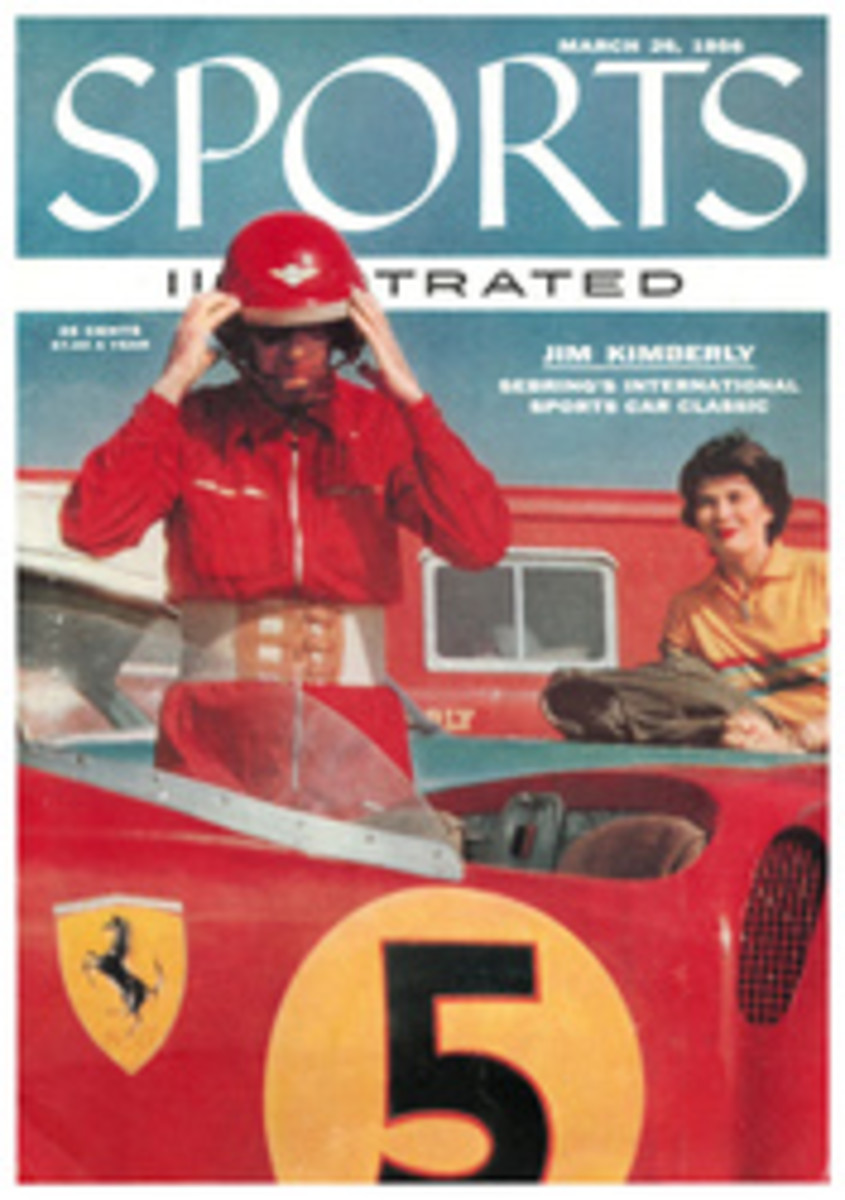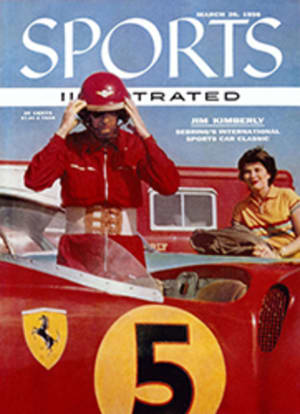
IT WAS 'FINISTERRE'
Nine hours after his gray-hulled yawl Finisterre slid past Morro Castle at 3:36 a.m. March 13 to be declared winner on corrected time of the St. Petersburg-Havana race, Carleton Mitchell was contentedly sipping a drink by the edge of the salt-water swimming pool of Havana's swank Hotel Nacional. Tanned and tired from 63 hours and 36 minutes of drifting and sailing hard on the wind through the Gulf of Mexico and the Florida Straits, he had the air of a man who had earned some rest and was going to enjoy it. For, by winning the 284-mile grind from St. Petersburg, Mitchell and Finisterre had wrapped up one of the biggest prizes in yacht racing circles—the Florida Governor's Cup, awarded each year to the boat that scores the most points in the five races that make up the southern ocean racing circuit.
"You can't tread on the ghosts of your predecessors," said Mitchell, "but I think this year was the fairest test of sailing we could possibly have had. You had those five races, with different conditions in each race."
The particular ghost that Mitchell had in mind was that of Hoot Mon, the 40-foot yawl which had won the southern circuit the two previous years, and, more to the point, had taken the trophy in 1955 by whipping Finisterre in a tight one-two finish at Havana. Hoot Mon has since gone out of southern competition (SI, March 5), but her ghost is very much alive in Mitchell's mind. "I wish Hoot Mon were still here," he said earnestly. "I think the results would have been the same."
The ghost, in a sense, was reincarnated this January by the addition to the fleet of a red-hulled 40-foot cutter named Comanche, captained by Engineering Contractor Jack Price of Miami and manned by much the same crew that kept Hoot Mon a jump ahead of Finisterre last year. But Comanche was not the only threat to Finisterre in the circuit. As the season unwound, one boat after another made a run at the broad-beamed 39-foot yawl.
Finisterre took them on one by one. Comanche was first, and took the first meeting. The season opener Jan. 20, the 48-mile Ft. Lauderdale-Bimini race, began with a windward leg in light, flukey air and ended with a strong spinnaker run. Finisterre worked herself into a bad position on the windward leg by moving too close to the Florida shore, where the wind went almost flat. Comanche followed the same course for a while, but then moved off the beach into the Gulf Stream, found a good northwest breeze and rode it into Bimini to come home a winner in her very first race. Mitchell salvaged fourth place.
In the next race, the Lipton Cup on Jan. 28 over a 30-mile triangular course off Miami Beach, Finisterre got it back. The wind was blowing at 20 mph—perfect weather for a heavy little boat and she won it all the way. In the following race, 184 miles from Miami to Nassau, the breeze blew even harder. Wind indicators consistently read above 25, and there were gusts up to 40. All through the fleet, sail tracks ripped off and winches jammed from the force of wind on the full-bellied racing sails. Even Finisterre had trouble. With the race virtually won as she passed Great Stirrup Light only 60 miles from Nassau, her headstay suddenly let go. "The mast was whipping around like a fishing rod," Mitchell said. "We thought it was going to go any second." But the spar held until a new fitting could be set on. Fifteen miles later her mainsail split in two. By the time another sail was hoisted, Dr. Luis H. Vida√±a's 67-foot Criollo had taken a commanding position and won the race, with the battered Finisterre second. Comanche could not do better than 12th. And when Finisterre took the 30-mile Nassau Cup race Feb. 4, with Criollo second, Comanche was virtually out of the Governor's Cup competition for good.
That brought Finisterre into the climactic Havana race leading the circuit with a total of 107.6 points, 13.1 ahead of her nearest rival and 31.5 ahead of Comanche. But with the big St. Petersburg-Havana race counting for 48% of the entire total, Mitchell was assured of nothing. Furthermore, Dr. Luis Vida√±a, now his closest competitor, had come into the circuit this year with Criollo determined to win or else. "When I buy Criollo," he said, "I do it because I want a boat who can win three prize—first to finish, first in fleet, first in Class A. With my other boat, Ciclon, I were always among first three, but I never be first finisher like Miami-Nassau." Criollo had sailed no less than 5,000 practice miles before the circuit began, and with four good races behind them, her young crew was, according to the proud skipper, as efficient as an ocean-racing crew can get.
When the race finally got under way, if it can be called that, in a nearly flat calm at noon March 10, it turned out that Mitchell and Vidaña were right. It was, for the most part, a big-boat race, although Criollo was never really in contention. When the gun sounded, Criollo and Finisterre were sitting close in shore, almost motionless, their spinnakers drooping in limp creases from their halyards. Farther offshore Ciclon, skippered this year by Manuel Garcia Nava of Havana, moved along in a slight breeze, then picked up a southwesterly, and slid well ahead of the fleet. Gradually the other boats caught the southwesterly, dropped their spinnakers, and came up close-hauled to beat out of Tampa Bay.
A THREE-WAY DUEL
When the yachts reached the southwest channel at the mouth of Tampa Bay, a three-way duel had been set up for the lead between Ciclon, the 80-foot scratch boat Valiant and Fred Guggenheimer's 67-foot cutter Mogu. Splitting tacks with Valiant, Mogu moved into second place, then tacked four times inside the smaller Ciclon and rounded the sea buoy into the Gulf of Mexico in first place. At this point, with Criollo moved up to fifth and Finisterre well back in the fleet, the wind gave out altogether and when the sun went down the fleet was once again motionless.
That night at 12:45, the port watch on Mogu heard the slapping of a boat moving up in the calm, and Valiant, gliding under some mysterious breeze of her own, slid alongside like a great white shark, hung there for about five minutes, and then moved out to take the lead by a quarter of a mile. By 7 o'clock Sunday morning, with the wind freshening from the southeast, Mogu made up the distance, and for the next 18 hours, as the rest of the fleet dropped out of sight astern, the two big yachts had it out boat for boat like two Snipes on an afternoon race. Finally, after a tense luffing match at about 10:30 Sunday night, Valiant began to drop steadily astern. At 3 a.m., just as Mogu's crew was thrashing around on the wet foredeck changing to a smaller headsail in the freshening breeze, Valiant's Genoa sheet snapped in two. That, as far as the contest for first boat into the harbor was concerned, was the race.
Criollo, defending the honor of Cuba, was at this point pooping along in light winds a dozen miles to leeward and 20 miles behind, a fact which was made known to the reception committee in Havana by radio and Coast Guard patrol plane. When Mogu came boiling past Morro Castle at 4:45 Monday afternoon, she was met by a boatful of shrieking Americans and very somber Cubans. As soon as Mogu touched the dock, Morley Guggenheimer, the pretty blonde wife of the owner, jumped aboard, threw her arms around her husband and yelled, "Those Cubans are dyin'." They died a little more when Criollo's handicap ran out and it became apparent that she had not only lost as first boat, but would lose in her class as well. And when Finisterre finally checked in at 3:36 Tuesday morning, with enough handicap time saved to beat Mogu by 48 minutes for first place in the race and thus clinch the Governor's Cup, the silence at the International Yacht Club was deafening. The only cheerful man aboard Criollo was Dr. Vidaña himself, who congratulated everybody, asked everybody to lunch and had Fred Guggenheimer hoisted triumphantly aboard, where he was enveloped by Vidaña in a warm Latin bearhug.
Back at the Nacional, Carleton Mitchell was plainly pleased. What pleased him most was not so much that Mitchell the sailor had won the southern circuit. He had done that twice before in 1952 and 1953 with the 57-foot yawl Caribbee. His real pleasure came from the performance of Finisterre, the design of which he had spent two years working out with Sparkman and Stephens, and which had proved itself, as Mitchell said, under all conditions. "No other small boat in history has ever been a heavy-weather boat," he said, thinking back to Lipton, Miami-Nassau and Nassau Cup. "And it's impressed everybody because it's never happened before. We've always felt we went equally well in light weather, and here in the Havana race we proved it. I wouldn't be surprised if Finisterre started something of a revolution in boat design."
[originallink:10467406:42772]
FT. LAUDERDALE-BIMINI (NO CLASS)
First Finisher—Hilaria
Winner—Comanche
Second—Figaro
Third—Hilaria
Fourth—Finisterre
LIPTON CUP (NO CLASSES)
First Finisher—Valiant
Winner—Finisterre
Second—Spray
Third—Comanche
Fourth—Cozy II
MIAMI-NASSAU
First Finisher—Criollo
Winner—Criollo
Class A—Criollo
Class B—Jubilee
Class C—Finisterre
NASSAU CUP (NO CLASS)
First Finisher—Criollo
Winner—Finisterre
Second—Criollo
Third—Jubilee
Fourth—Comanche
ST. PETERSBURG-HAVANA
First Finisher—Mogu
Winner—Finisterre
Class A—Mogu
Class B—Figaro
Class C—Finisterre

